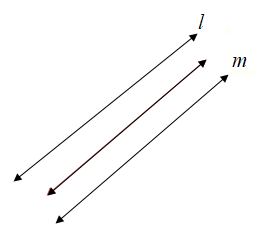
Concept explainers
Draw and describe the locus of points in the plane that are equidistant from parallel lines l and m.
_________________________________________
________________________________________

To draw and describe:
The locus of points in the plane that are equidistant from parallel lines l and m.
Answer to Problem 1CT
Solution:
The locus is in between both lines and is parallel to both.
Explanation of Solution
Definition:
A locus is set of all points and only those points that satisfy a given condition or set of conditions.
In must be noted that, the phrase “all points and only those points” has dual meaning as follows:
1. All points of the locus satisfy the given condition.
2. All points satisfying the given locus conditions are included in the locus.
Calculation:
A locus maintains an equal distance from each line.
Thus, we obtain that the locus must be half way between the two lines. In addition, since it maintains a constant distance, it must be parallel to both.
From this we came to know that the locus equidistant from two parallel lines l and m, is a line parallel to both l and m and halfway between them.

Conclusion:
The path formed by all points the same distance from two parallel lines will be one line halfway between the parallel lines.
Want to see more full solutions like this?
Chapter 7 Solutions
Elementary Geometry for College Students
Additional Math Textbook Solutions
College Algebra (Collegiate Math)
Calculus for Business, Economics, Life Sciences, and Social Sciences (14th Edition)
Elementary Algebra For College Students (10th Edition)
Intro Stats, Books a la Carte Edition (5th Edition)
Algebra and Trigonometry (6th Edition)
Elementary and Intermediate Algebra: Concepts and Applications (7th Edition)
- 2) Based on the given information and the diagram, a. Which congruence statements can be proven? Select all that apply.Given: Overline OR is congruent to overline OQ, angle N is congruent to angle PProve: angle 3 is congruent to angle 5A. Overline ON is congruent to overline OPB. Angle 1 is congruent to angle 2C. Overline ON is congruent to overline OR and overline OP is congruent to overine OQD. angle 1 is congruent to angle 3 and angle 2 is congruent to angle 5There are more than one correct answerarrow_forwardnt/Ray Skew Lines/ J K # H L 艹 G C D E F Diagrams m Three Points th a Protractor Answer Attempt 3 out of 3 el 1 is congruent to Submit Answer 103 Log Out REE Young the → C # $arrow_forward4:54 PM Thu Jan 16 cdn.assess.prod.mheducation.com Question 3 The angle bisectors of APQR are PZ, QZ, and RZ. They meet at a single point Z. (In other words, Z is the incenter of APQR.) Suppose YZ = 22, QZ = 23, mz WPY 38°, and mzXQZ = 54°. Find the following measures. Note that the figure is not drawn to scale. P W Z X R Y mzXQW WZ = = 0 mz XRZ = 0°arrow_forward
- Ja дх dx dx Q3: Define the linear functional J: H()-R by تاریخ (v) = ½a(v, v) - (v) == Let u be the unique weak solution to a(u,v) = L(v) in H₁(2) and suppose that a(...) is a symmetric bilinear form on H() prove that a Buy v) = 1- u is minimizer. 2- u is unique. 3- The minimizer J(u,) can be rewritten under J(u)=u' Au-ub, algebraic form Where A, b are repictively the stiffence matrix and the load vector Q4: A) Answer only 1-show that thelation to -Auf in N, u = 0 on a satisfies the stability Vulf and show that V(u-u,)||² = ||vu||2 - ||vu||2 lu-ulls Chu||2 2- Prove that Where =1 ||ul|= a(u, u) = Vu. Vu dx + fu. uds B) Consider the bilinear form a(u, v) = (Au, Av) + (Vu, Vv) + (Vu, v) + (u, v) Show that a(u, v) continues and V- elliptic on H(2) (3) (0.0), (3.0)arrow_forwardQ1: A) fill the following: 1- The number of triangular in a triangular region with 5 nodes is quadrilateral with n=5 and m=6 nodés is 2- The complex shape function in 1-D 3- dim(P4(K))=- (7M --- and in the and multiplex shape function in 2-D is 4- The trial space and test space for problem -Auf, u = go on and B) Define the energy norm and prove that the solution u, defined by Galerkin orthogonal satisfies the best approximation. Q2: A) Find the varitional form for the problem 1330 (b(x)) - x²=0, 0arrow_forwardcould you help?arrow_forward(ii)arrow_forwardA convex polygon is said to be regular if all of its sides have the same length and all angles between sides are the same. Let Pr denote the regular convex n-sided polygon. Thus, P3 is the equilateral triangle, P₁ is the square, P is the pentagon etc. Compute a formula for the size of any internal angle of Pn.arrow_forward+ Recall that a map, f: R2 R², is an isometry if |P-Q| = |ƒ(P) — ƒ (Q) for all pairs of points P and Q in R². Thus, f is a distance preserving map. Show that an isometry, f: R² → R² also preserves angles. In other words if two line segments meeting at a point determine an angle a, their image line segments meeting at the image of that point also determine the angle a.arrow_forwardUsing Harriott's formula for the area of a triangle on the unit sphere, S2, compute the Euler characteristic X(S2). Make sure to explain what the Euler characteristic is. (The point of the exercise is to show that this notion is well-defined.)arrow_forwardProve Harriot's Formula (Area of a Triangle on a Sphere).arrow_forwardIn rhombus ABCD, diagonals BD¯¯¯¯¯¯BD¯ and AC¯¯¯¯¯AC¯ intersect at point E. If BE = 4n – 3 and EC = 2n + 5, which expression can be used to represent AD?arrow_forwardarrow_back_iosSEE MORE QUESTIONSarrow_forward_ios
- Algebra & Trigonometry with Analytic GeometryAlgebraISBN:9781133382119Author:SwokowskiPublisher:Cengage
